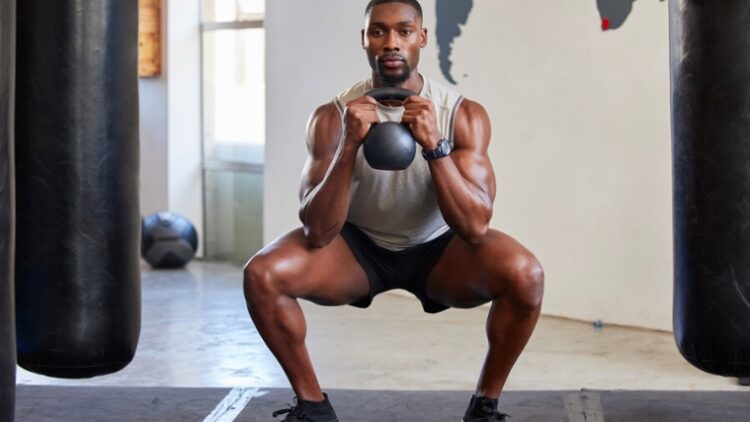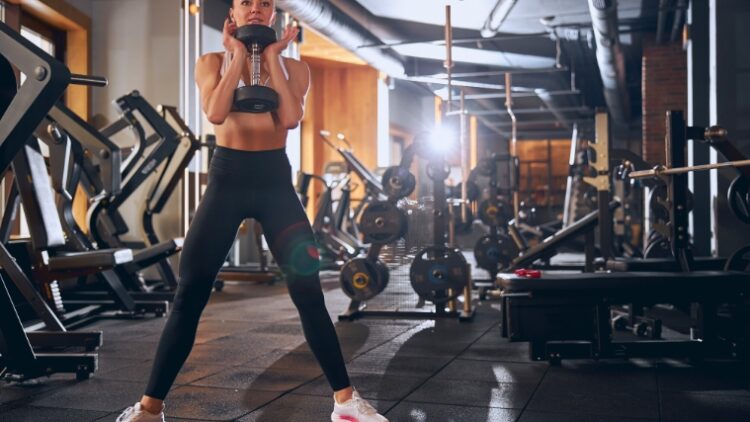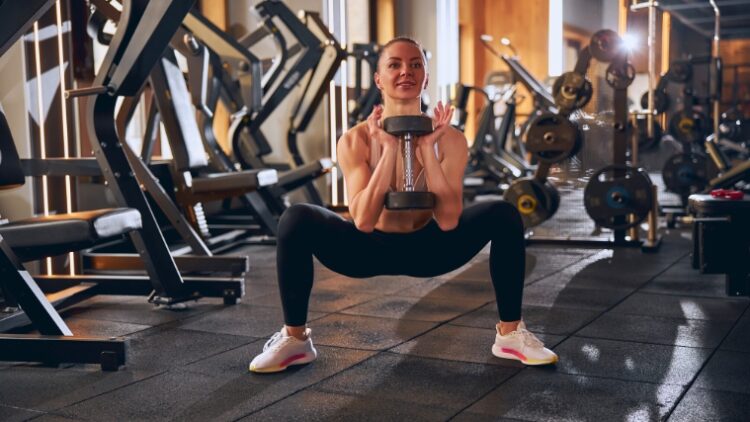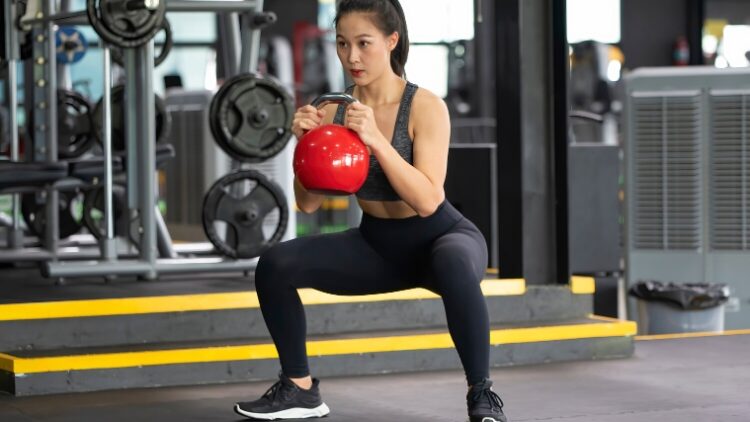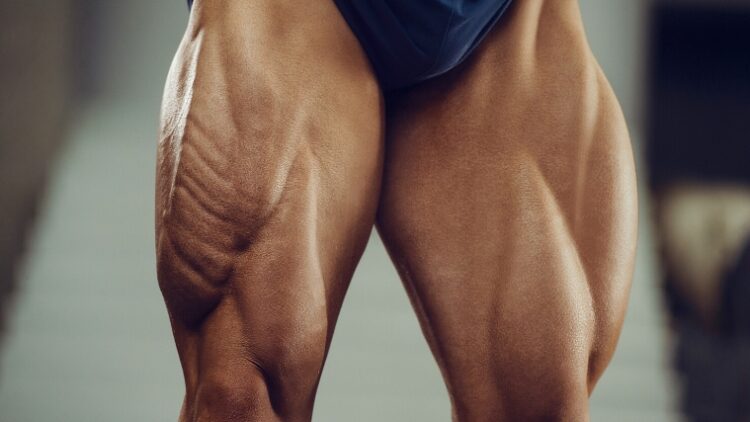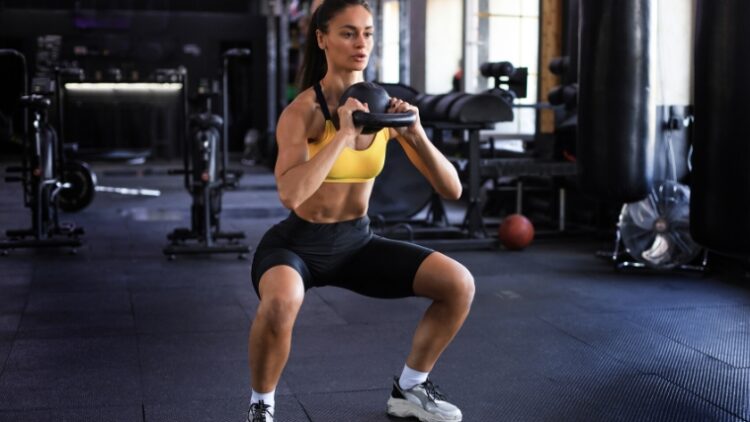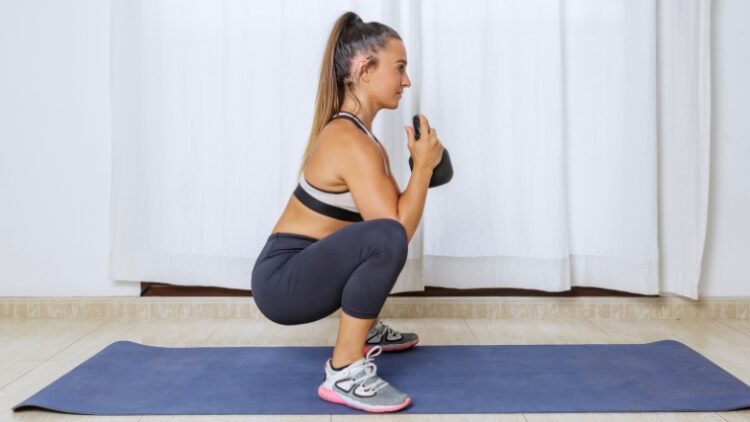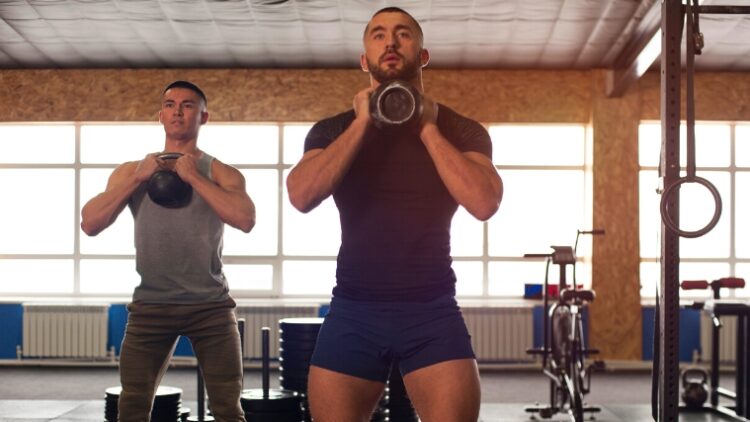How to Do the Sumo Goblet Squat — Benefits, Form, Variations, and More (original) (raw)
A good leg day should, incontestably, include some form of squat. Most people, whether they do front squats or back squats, work with the barbell. Barbell squats are all well and good — they teach you one of the fundamental movement patterns and target most of the musculature in your lower body.
However, the sumo goblet squat works parts of your legs that may go neglected by standard barbell squatting. This variation enables you to focus more on your core, adductors, and quads. It’s a great way to switch up your leg training, add some dynamic power, and improve your mobility all at once.
Credit: PeopleImages.com – Yuri A / Shutterstock
Here’s how to do the sumo squat with a goblet, plus some extra information about alternatives, muscles worked, and a whole lot more.
- How to Do the Sumo Goblet Squat
- Sumo Goblet Squat Sets and Reps
- Common Sumo Goblet Squat Mistakes
- Sumo Goblet Squat Variations
- Sumo Goblet Squat Alternatives
- Muscles Worked by the Sumo Goblet Squat
- Benefits of the Sumo Goblet Squat
- Who Should Do the Sumo Goblet Squat
- Frequently Asked Questions
Learning the sumo goblet squat is straightforward enough if you already know how to squat. There are some technical differences when performing the sumo squat to be aware of, particularly regarding the width of your stance and the position of your feet and shins.
To start off correctly and build your confidence with this movement read through the step-by-step instructions below. You’ll need a dumbbell or kettlebell for this one.
[Read More: The Best Dumbbell Exercises and Workouts]
Step 1 — Find Your Start Position
Credit: YAKOBCHUK VIACHESLAV / Shutterstock
Hold the weight you’re using at chest level with both hands. The dumbbell or kettlebell shouldn’t rest against your torso. Establish your stance by moving your feet out wide, at least double the width of your shoulders to start. Point your toes out to a 45-degree angle and feel your body weight distribute evenly across your feet.
Coach’s Tip: Start in your standard squat stance first and then move your feet out wide.
Step 2 — The Descent
Credit: YAKOBCHUK VIACHESLAV / Shutterstock
Push your hips back slightly and bend your knees simultaneously as you sit down into a squat. Think about dropping your hips straight downward and driving your knees out to the sides, such that they track in line with the angle of your feet.
Coach’s Tip: Remember to keep your spine neutral, chest up, core tight and eyes neutral throughout the movement.
Step 3 — Push Back Up
Credit: YAKOBCHUK VIACHESLAV / Shutterstock
Lower yourself down until your thighs are parallel or below parallel to the floor. Hold at the bottom for 1-2 seconds. To begin the upward movement, push your feet into the ground, allow your knees to straighten, and bring your hips slightly forward.
Coach’s Tip: As you stand up, squeeze your glutes and maintain a neutral spine.
Sumo Goblet Squat Sets and Reps
You don’t always have to change up the exercise to get stronger results. If you want to add some extra challenge to the sumo goblet squat, you can tweak your set and rep prescription. Here are a few different ways to program the exercise:
- For Muscle Mass: To train for muscle mass, up your volume and perform 3-5 sets of 8-12 reps.
- For Strength: Strengthen your glutes by slowing down your tempo, descending for three full seconds, and then pausing at the bottom for three seconds. Do 2-4 sets of around 5 reps.
- For Endurance: To improve your endurance, up your rep count. Go for 2-4 sets of 12 to 12 repetitions with limited rest inbetween.
Common Sumo Goblet Squat Mistakes
Most squat mistakes involve posture in some form; a weak core or inactive glutes can compromise how you perform an exercise like the sumo goblet squat. Make sure you stretch thoroughly before performing any sumo stance squat. Beyond that, here are some other common mistakes to watch out for:
Lifting Too Heavy
If you find yourself rounded forward or the weight is resting on your body as you perform a sumo goblet squat, you should probably lighten the load. Holding a weight in the goblet position should challenge your upper back, but it shouldn’t take away from the exercise as a whole.
Credit: pnarongkul / Shutterstock
If you find it harder to hold the goblet when you perform sumo squats than squatting itself, you’re probably lifting too heavy — go for a lighter weight.
Standing Too Wide
Sumo squats, whether you hold a weight in the goblet position or not, are wide. But they shouldn’t be so wide that you can’t sit down properly.
At the bottom of the sumo squat, your shins should be perpendicular to the floor. If they aren’t, you’re likely standing too wide (the same holds true if your knees don’t track over your toes). Bring your stance in until you can hit these postural benchmarks.
Leaning Forward Excessively
Remember that, despite the wide stance, the sumo goblet squat isn’t a deadlift variation. As such, you should try to maintain an upright torso the entire time. Some degree of inclination is inevitable depending on how you’re built, but if you find yourself leaning too far forward, you may need to address your technique. Your shoulders should stay on top of your hips the entire time.
Sumo Goblet Squat Variations
Once you have mastered the technicality of the sumo goblet squat you can amplify it by adding different components to make it powerful, dynamic, and plyometric. Switch up your sumo goblet squat by hitting some of these variations instead:
Sumo Squat Jump
The sumo squat jump is an excellent way to add some plyometrics to your leg workout. You can do this one with either a dumbbell or a kettlebell that starts on the floor. From the bottom position of the squat, grab the weight and explode upwards.
You can also work with this exercise as a technical primer or as part of a warm-up circuit without using any weight at all. If you’re new to power training, starting with just your body weight is probably wise.
Sumo Squat
Ditch the goblet position and grab a barbell instead if you want to load up on extra weight. Working with the barbell and heavier weights will challenge your pelvic floor muscles and deep core stability.
Sumo squats with the barbell are great for warming up your hips prior to standard squats, or as part of a dynamic mobility routine. Note that just because you’re working with the barbell, you don’t need to go ultra-heavy to make this movement effective.
Sumo Squat Alternatives
If the sumo goblet squat is just not for you, try some of these knee-dominant alternatives. These exercises not only hit the same muscles, but you can perform all of them with a weight held in the goblet position as well.
Lateral Lunge
If you’re familiar with lunges, you know they’re a leg day staple, and for good reason. Lunge variations are one of the best ways to improve the strength of your glutes, thighs, quads, and deep hip musculature.
You can hold a weight in the goblet position and perform lateral lunges to get some side-to-side stimulation going for better muscular coordination or improved athletic performance.
Goblet Step-Up
Step-ups are great for training your legs unilaterally and teaching you how to maintain a vertical torso. This exercise helps you focus on your quads, glutes, and groin muscles.
Holding a weight in the goblet position while you step up onto an elevated surface is a great way to train and refine your core bracing and overall stability. This exercise is also quite scalable by simply adjusting the height of the surface you step onto.
Kettlebell Deadlift
Squats are all well and good, but you should probably perform at least one posterior chain exercise during your leg workouts as well. The kettlebell deadlift is a fantastic option since you can work with the same implement.
Deadlifts of all shapes and sizes train your hamstrings, glutes, and lower back. They also help open up your hips; all of which are required qualities for the sumo goblet squat itself. Pairing the two together would make a phenomenal superset.
Muscles Worked by the Sumo Goblet Squat
Working in a sumo stance changes up the muscular recruitment patterns in your lower body significantly. Some literature shows that sumo exercises result in higher recruitment of the hamstrings, lower back, and gluteal muscles than their narrow-stance counterparts. (1)
The sumo goblet squat isn’t your run-of-the-mill squat variation. Here are the major muscle groups required to make the movement work.
Quadriceps
Your quadriceps, or, colloquially, “quads,” consist of four distinct muscular regions: The rectus femoris, vastus lateralis, vastus medialis, and vastus intermedius. The rectus femoris actually helps to bend your body at the hips, but the quads are mostly a knee extensor.
During the sumo goblet squat (and all other squat variations), your quads are called into action to help straighten your legs.
Glutes
Your glutes are the largest muscles in your body, whether you train them or not. Their primary function is to extend your hips and influence the rotation of your leg in your pelvis. During the sumo goblet squat, the deep gluteus medius muscle performs a bulk of the work as your thigh moves into significant abduction.
Hip Adductors
“Adduction” refers to motion toward the midline of your body. The adductor magnus is a large and powerful muscle that lies on the inside of your thigh and plays a significant role in controlling your pelvis while you sink into a deep, wide squat.
If your adductors are tight or weak, you may find that the sumo goblet squat is simply too difficult to perform properly.
Core
The group of muscles in your core consists of the abdominals, obliques, and spinal erectors. Your abdominals pull your pelvis and ribcage together, while your obliques control how much your trunk rotates and tilts.
Credit: tsyhun / Shutterstock
The sumo goblet squat may not be a lower-back dominant exercise, but it will train your core from back to front. A strong and stable core correlates to being a good squatter, whether you use a sumo stance or otherwise.
Benefits of the Goblet Sumo Squat
If you haven’t been convinced thus far that the sumo goblet squat is for you, here’s a short list of the many benefits you stand to gain from the movement.
Better Postural Stability
The anterior load of the sumo goblet squat creates a counterbalance for your body. This allows your core to contract and keep your spine in a neutral position, which should create better overall posture. This turns the sumo goblet squat into a two-for-one; you can work your legs and improve your trunk stability simultaneously.
It’s Versatile and Convenient
One of the most underrated aspects of resistance training movements is convenience. You can perform the sumo goblet squat just about anywhere as it doesn’t require complex machinery or a lot of free space.
The sumo goblet squat is suitable for beginners and advanced athletes alike, depending on whether you work with weights or just your own body weight. You can also quickly add a dynamic element to the movement by jumping at the top, making the sumo goblet squat relevant for just about any training goal.
It’s Great for Athletes
If you play a sport, you should squat. The ability to transfer force through your body is integral to all areas of athletic performance, and the sumo goblet squat is a fantastic way to refine that quality.
Athletes, whether they practice on the field or the court or the mats, should be mobile, flexible, and explosive. The sumo position helps you develop those attributes.
More Core Strength
The goblet hold is a great way to teach beginners how to brace their cores. Front-loaded exercises improve core strength and teach you how to create and maintain a neutral spine while moving your lower body into a squat position.
Who Should Do the Sumo Goblet Squat
Whether as a stepping stone to a more complex exercise or a mainstay movement on its own, you can utilize the sumo goblet squat regardless of what your goals in the gym may be. Here’s how:
Beginners
Squats can be intimidating for newcomers. If you’re just getting started on your fitness journey, you don’t have to jump right into the squat rack to work with the barbell if you’re not comfortable.
Credit: Juan_Algar / Shutterstock
You can use the sumo goblet squat as your main lower-body exercise for as long as you find it challenging and rewarding. It will teach you how to balance your body, contract your core against a weight, and maintain proper joint stability.
Athletes
Athletes who are comfortable with the rigors of resistance training can incorporate the sumo goblet squat as part of their pre-squat warm-up. Working through your end-range hip mobility under light load is a great way to prepare the small muscles in your hips for the heavier lifting to follow.
Credit: Paul Biryukov / Shutterstock
The sumo goblet squat is also relevant for strength athletes like weightlifters who need to really open up their hips prior to hitting the barbell. The exercise hits all the marks of a good warm-up; it primes your hips and knees, helps you unlock your hips, and turns on your core.
General Populations
The sumo goblet squat isn’t just for athletes and hardcore gymgoers — it’s great for just about anyone who wants to be more physically active and feel better. This movement not only activates almost your entire lower body, but also transfers to everyday movement patterns.
How often do you find yourself in a wide stance trying to lift something heavy, or reaching for a far-away object? Your hips and core need to be strong enough to manage those tasks. The sumo goblet squat can help you guarantee that your body can handle whatever you throw at it.
Make It a Sumo
The sumo squat may be quite technical and demanding, but it’s equally rewarding. Squatting with an exaggerated, wide stance is a great way to recruit underused muscles, beef up your core strength and stability, or just inject some much-needed newness into your workout routine.
Don’t be afraid to go wide — add the sumo goblet squat into your training repertoire and reap the benefits for yourself. The next time you go to squat, make it sumo.
FAQs
Still scratching your head over the sumo goblet squat? Here are a couple of questions that may be bouncing around in your head.
What's the difference between a goblet squat and a sumo goblet squat?
The goblet squat is traditionally performed with your feet in a moderate, toes-forward position. On the other hand, the sumo goblet squat requires that you spread your feet far and point them outward. This adjustment will engage different muscles and challenge your mobility in a distinct manner.
What if I can’t break parallel?
First things first, squatting with your thighs parallel to the floor, or deeper, is in no way intrinsically harmful to your knees. The deeper you can squat with good form, the stronger your joints will become.
If you can’t sit very low into the sumo goblet squat, restricted hips are the most likely culprit. The extreme levels of thigh abduction from taking a wide stance can be quite challenging for newcomers. Your best bet is to take it easy and work with a slow tempo, or incorporate some hip mobility exercises in your spare time.
What’s the best weight to use on the sumo goblet squat?
How much weight you work with on any exercise depends on your individual strength levels and how long you’ve been in the gym. Overall, your best bet is to begin conservatively, using a very light dumbbell or kettlebell when learning the sumo goblet squat for the first time.
As you get comfortable with the movement, you can gradually ramp up in five to 10-pound increments every few weeks as you advance.
References
- Erdağ, Deniz & Yavuz, Hasan. (2020). Evaluation of Muscle Activities During Different Squat Variations Using Electromyography Signals. 10.1007/978-3-030-35249-3_114.
Feature Image: pnarongkul / Shutterstock
